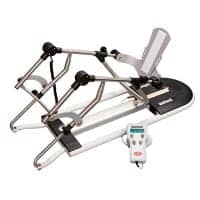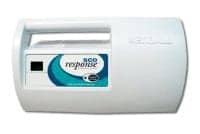
CPM units provide a much better treatment than the immobilization of a healing joint.
As we embark on the new year of 2012, we all should take a little time to reflect on 2011. I, and many of our readers, should take a little time to embrace our accomplishments and acknowledge our shortcomings. With that said, let me acknowledge some shortcomings of mine. Thanks to some very attentive readers of the “ICC Prep” articles, it has been brought to my attention that a few facts are not entirely correct.
First, let’s start with the June 2011 issue when I wrote an article titled “Plan Not to Fail.” In this article I mention a condition called acidosis. Metabolic acidosis of the blood can be caused by hyperventilation, which is correctly stated in the article. However, this condition of acidosis is caused by a decrease in carbon dioxide in the blood, not an increase in carbon dioxide, which is stated in the article. This article goes on to state that a person experiencing hyperventilation can breathe into a bag, which will increase the carbon dioxide in the blood, and in turn this moves the blood pH up the scale toward the more alkaline or base portion of the pH scale, which is correct. So, low carbon dioxide in the blood will create acidosis, not alkalosis, and it is created by hyperventilation and not hypoventilation. I would like to thank Barry Suslowicz, MBA, BSc, CBET, and Robert Hijazi, PhD, for catching this error.
Toco Correction
The other bit of misinformation was noticed in the last article in December 2011 on fetal monitoring by Biomed Tech II Darrell Anderson. The article states that contractions are measured in mm/Hg by the toco transducer. This is a little misleading as a toco—or tocodynamometer—performs a qualitative measurement. So the toco pressure is a relative measurement, ie, more or less pressure in the uterus. However the graph of the toco pressure is printed on the UA portion of the strip chart, which is labeled in mm/Hg and is referenced to the 10 mm/Hg scale.
To perform a quantitative measurement of pressure with this technology you must measure IUP—or the intrauterine pressure. IUP measures amniotic fluid pressure with the use of a transcervical intrauterine catheter and an externally mounted pressure strain gauge. The IUP pressure is also graphed on the UA portion of the strip chart recorder, and the pressure is plotted on a 0 to 100 mm/Hg scale. Again, I would like to thank Darrell and also Robert for bringing these errors to my attention, which should benefit all the readers of the “ICC Prep” articles.

SCDs can include a controller, tubing, and compression sleeves that may deliver circumferential, sequential, and gradient compression.
With my sincere apologies out of the way, let us see if we can cover some other technologies you may find questions about on the CBET exam, and I will try my best to not interject misinformation about these technologies. Let us take a look at two items, CPMs and SCDs.
CPMs
CPMs—or continuous passive motion machines—are used after joint surgery or a joint injury. You will most likely find these units being applied to a knee or shoulder. Clinical studies have proven that continuous passive motion is a much better treatment than immobilization of a healing joint. CPM therapy promotes the regeneration of cartilage in an injured joint and helps maintain joint nutrition and lubrication, which helps in the growth of the new cartilage. Immobilization of a joint during a healing process inhibits synovial fluid circulation, which decreases nutrients to the joint and increases healing time. CPMs also assist in the patients’ range of motion to the injured joint, which speeds recovery time of the joint if range of motion is maintained.
SCDs
SCDs—or sequential compression devices—are therapy devices designed to limit the development of deep vein thrombosis, or blood clots. The official name of these devices is lymphedema pumps, but most BMETs and CEs refer to these devices as SCDs. Clinicians use this type of therapy when patients are immobilized over long periods of time, at which point blood tends to pool in the calf of the lower leg, and this pooling of blood can create a thrombosis. SCDs can also come in what is sometimes referred to as a foot pump. Much like the lymphedema pumps that have sleeves that cover the calves, the foot pump has sleeves that inflate and deflate around the foot, which simulates walking and helps to keep blood clots from forming. These are very simple machines with a pump, a timer, and sleeves that inflate and deflate—and in turn keep blood moving in the immobilized patient’s legs.
Once again, I apologize for the mistakes in earlier articles and hope the corrections help. I hope you will find the information about CPMs and SCDs helpful. Have a wonderful 2012, and keep studying!
John Noblitt, MAEd, CBET, is the BMET program director at Caldwell Community College and Technical Institute, Hudson, NC. For more information, contact .
Review Questions:
- Hyperventilation can cause a blood disorder known as____.
- Ventilation
- Carbon dioxide
- Acidosis
- Alkalosis
- Tocodynamometers measure pressure____.
- Quantitatively
- Qualitatively
- In mm/Hg
- cm/H2O
- Sequential compression devices are used to inhibit____.
- Infection
- Range of motion
- Thrombosis formation
- Synovial fluid
- CPMs promote which of the following?
- Joint nutrition
- Synovial fluid circulation
- Range of motion
- All the above
See the answer
See the answer
See the answer
See the answer





